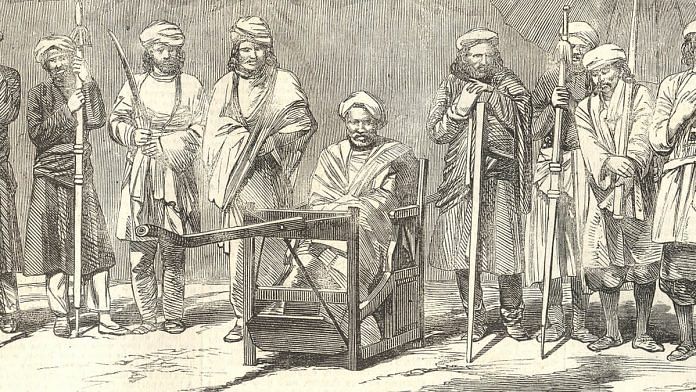The revolt against the British caught fire in 1857, and spread in the western regions of Bihar too.
While many zamindars and local leaders were supporting the government, others actively backed the rebelling forces. Kunwar Singh, a zamindar in Jagdishpur, whose estate was being taken away by the Revenue Board, came to the forefront and took leadership in Bihar. The rebels of Danapur, Chota Nagpur, Manbhum, Singhbhum, and Palamu looked up to Kunwar Singh and offered to help him in the struggle.
Joined by the mutinying sepoys of the seventh, the eighth, and the 40th regiments of Bengal Native Infantry, which marched from Danapur, Singh and his men besieged the British at Arrah, Bihar. But Major General Vincent Eyer, who was on his way to Allahabad, heard about the siege and turned to Arrah, disregarding direct orders against doing so. His forces defeated Kunwar Singh and his companions at Bibiganj on 3 August.
It is said that after receiving reinforcements, General Eyre pursued Kunwar to Jagdishpur, but the zamindar had fled by the time the former’s forces arrived. Enraged, he then proceeded to destroy the palace of Jagdishpur and the houses of Singh’s brothers.
Singh continued his attacks against the British even at the age of 80 — his valour was second to none. Defeat at General Eyre’s hand had not deterred Kunwar — he took the fight out of Bihar and resisted the British with cooperation from rebel groups in other parts of India, including Rewa, Gwalior, Lucknow, and Kanpur.
Veer Kunwar Singh might be one of the lesser-known figures who fought in the Mutiny of 1857, but he contributed greatly and inspired many to take up arms in rebellion against the British. He is known endearingly in Bihar as Babu Veer Kunwar Singh. To commemorate his contribution to the freedom struggle, India issued a stamp in his honour in 1966. Veer Kunwar Singh University was also established in 1992 with its headquarters at Arrah, Bihar.
Also read: Don’t remember the 1857 Mutiny with Rani of Jhansi alone. You’re missing out on Uda Devi
A history of battles
In September 1857, Kunwar Singh made a failed attempt to enter Rewa, Madhya Pradesh, after which he went to Banda in Uttar Pradesh. From there, he carried on to Kalpi with his compatriot Nishan Singh. Joined by Gwalior troops, he fought in the Seige of Cawnpore (Kanpur), in which Nana Saheb Peshwa II’s troops and allies lost to the British.
Singh did not yield and marched towards Lucknow. In March 1858, he joined his comrades near Atraulia, Azamgarh. The British troops, under Lt General George Bryan Milman and Colonel tried to displace Kunwar Singh, but to no avail. He attacked the weakest positions of the British, thereby sustaining the rebellion and keeping Azamgarh under his control. Lord Mark Kerr and Sir Edward Lingard were then sent to relieve Azamgarh from Singh’s control. Upon hearing this news, Singh evacuated with a portion of his troops towards Ghazipur.
In an attempt to cross the Ganga to reoccupy Jagdishpur, Kunwar Singh fought British troops under Brigadier Douglas in April 1858. To prevent infection caused by bullet wounds on his arm spreading to the rest of his body, the brave warrior chopped it off and crossed to the other side of the Ganga at Shivapur Ghat.
As he reached Jagdishpur, a British armed force, led by Captain Le Grand, was already on its way. Le Grand’s forces suffered a severe repulse, but, worn out by fatigue and continuous fighting, Kunwar Singh was not destined to live long. He passed away on 26 April 1858, victorious in his last battle.
(Edited by Humra Laeeq)



